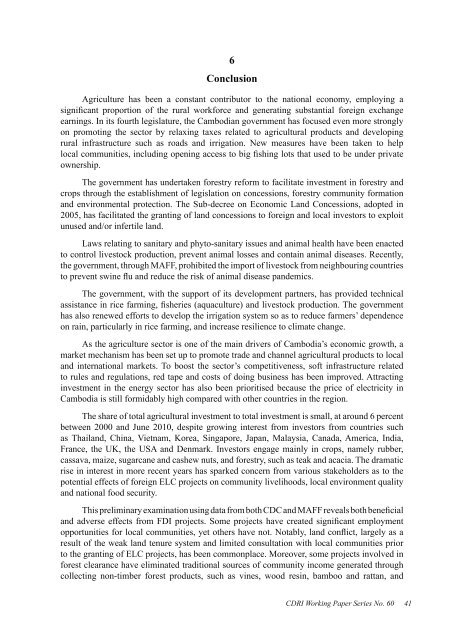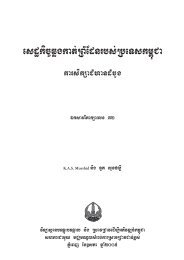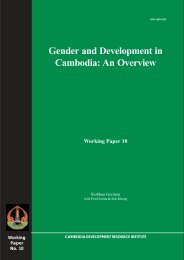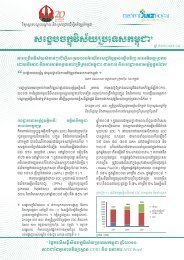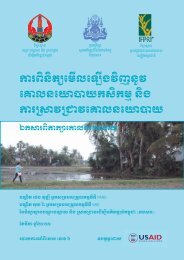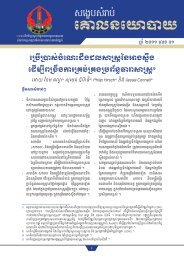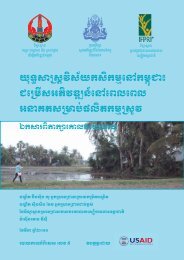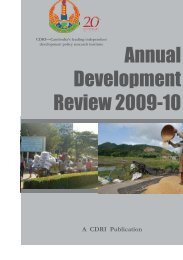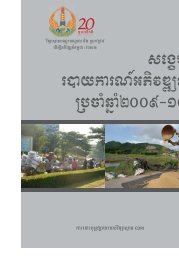Foreign Investment in Agriculture in Cambodia CDRI Working Paper ...
Foreign Investment in Agriculture in Cambodia CDRI Working Paper ...
Foreign Investment in Agriculture in Cambodia CDRI Working Paper ...
You also want an ePaper? Increase the reach of your titles
YUMPU automatically turns print PDFs into web optimized ePapers that Google loves.
6<br />
Conclusion<br />
<strong>Agriculture</strong> has been a constant contributor to the national economy, employ<strong>in</strong>g a<br />
significant proportion of the rural workforce and generat<strong>in</strong>g substantial foreign exchange<br />
earn<strong>in</strong>gs. In its fourth legislature, the <strong>Cambodia</strong>n government has focused even more strongly<br />
on promot<strong>in</strong>g the sector by relax<strong>in</strong>g taxes related to agricultural products and develop<strong>in</strong>g<br />
rural <strong>in</strong>frastructure such as roads and irrigation. New measures have been taken to help<br />
local communities, <strong>in</strong>clud<strong>in</strong>g open<strong>in</strong>g access to big fish<strong>in</strong>g lots that used to be under private<br />
ownership.<br />
The government has undertaken forestry reform to facilitate <strong>in</strong>vestment <strong>in</strong> forestry and<br />
crops through the establishment of legislation on concessions, forestry community formation<br />
and environmental protection. The Sub-decree on Economic Land Concessions, adopted <strong>in</strong><br />
2005, has facilitated the grant<strong>in</strong>g of land concessions to foreign and local <strong>in</strong>vestors to exploit<br />
unused and/or <strong>in</strong>fertile land.<br />
Laws relat<strong>in</strong>g to sanitary and phyto-sanitary issues and animal health have been enacted<br />
to control livestock production, prevent animal losses and conta<strong>in</strong> animal diseases. Recently,<br />
the government, through MAFF, prohibited the import of livestock from neighbour<strong>in</strong>g countries<br />
to prevent sw<strong>in</strong>e flu and reduce the risk of animal disease pandemics.<br />
The government, with the support of its development partners, has provided technical<br />
assistance <strong>in</strong> rice farm<strong>in</strong>g, fisheries (aquaculture) and livestock production. The government<br />
has also renewed efforts to develop the irrigation system so as to reduce farmers’ dependence<br />
on ra<strong>in</strong>, particularly <strong>in</strong> rice farm<strong>in</strong>g, and <strong>in</strong>crease resilience to climate change.<br />
As the agriculture sector is one of the ma<strong>in</strong> drivers of <strong>Cambodia</strong>’s economic growth, a<br />
market mechanism has been set up to promote trade and channel agricultural products to local<br />
and <strong>in</strong>ternational markets. To boost the sector’s competitiveness, soft <strong>in</strong>frastructure related<br />
to rules and regulations, red tape and costs of do<strong>in</strong>g bus<strong>in</strong>ess has been improved. Attract<strong>in</strong>g<br />
<strong>in</strong>vestment <strong>in</strong> the energy sector has also been prioritised because the price of electricity <strong>in</strong><br />
<strong>Cambodia</strong> is still formidably high compared with other countries <strong>in</strong> the region.<br />
The share of total agricultural <strong>in</strong>vestment to total <strong>in</strong>vestment is small, at around 6 percent<br />
between 2000 and June 2010, despite grow<strong>in</strong>g <strong>in</strong>terest from <strong>in</strong>vestors from countries such<br />
as Thailand, Ch<strong>in</strong>a, Vietnam, Korea, S<strong>in</strong>gapore, Japan, Malaysia, Canada, America, India,<br />
France, the UK, the USA and Denmark. Investors engage ma<strong>in</strong>ly <strong>in</strong> crops, namely rubber,<br />
cassava, maize, sugarcane and cashew nuts, and forestry, such as teak and acacia. The dramatic<br />
rise <strong>in</strong> <strong>in</strong>terest <strong>in</strong> more recent years has sparked concern from various stakeholders as to the<br />
potential effects of foreign ELC projects on community livelihoods, local environment quality<br />
and national food security.<br />
This prelim<strong>in</strong>ary exam<strong>in</strong>ation us<strong>in</strong>g data from both CDC and MAFF reveals both beneficial<br />
and adverse effects from FDI projects. Some projects have created significant employment<br />
opportunities for local communities, yet others have not. Notably, land conflict, largely as a<br />
result of the weak land tenure system and limited consultation with local communities prior<br />
to the grant<strong>in</strong>g of ELC projects, has been commonplace. Moreover, some projects <strong>in</strong>volved <strong>in</strong><br />
forest clearance have elim<strong>in</strong>ated traditional sources of community <strong>in</strong>come generated through<br />
collect<strong>in</strong>g non-timber forest products, such as v<strong>in</strong>es, wood res<strong>in</strong>, bamboo and rattan, and<br />
<strong>CDRI</strong> Work<strong>in</strong>g <strong>Paper</strong> Series No. 60<br />
41


